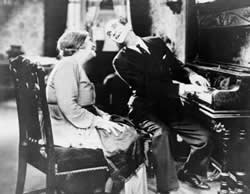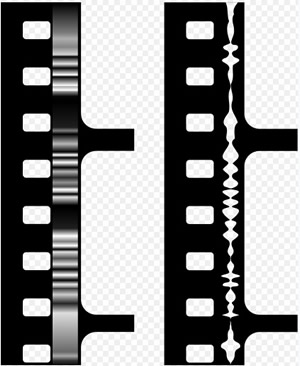Sound
 The earliest attempts to sound-sync movies date to the late 19th century (it was Edison's original plan). There were numerous
sound-sync devices, but none were very successful.
The earliest attempts to sound-sync movies date to the late 19th century (it was Edison's original plan). There were numerous
sound-sync devices, but none were very successful.
Effective sound movies had to wait for the development of the amplifier and some uniformity of format.
 Many early "talkies" used "vitaphone" a system that coupled a projector and a record player. However, this was soon replaced by sound on film systems. On film, analog sound could be variable density (left) or variable area (right). Digital sound was added to film in the 1990s.
Many early "talkies" used "vitaphone" a system that coupled a projector and a record player. However, this was soon replaced by sound on film systems. On film, analog sound could be variable density (left) or variable area (right). Digital sound was added to film in the 1990s.
The first movie to use synchronized sound in a big way was The Jazz Singer (1927). It was hugely successful. Studio execs thought (hoped) that sound was a fad but silent film rapidly became unprofitable.
Sound created big technical hurdles: cameras had to be redesigned and methods for invisibly capturing sound created. Many silent film stars were unable to make the transition to sound. Sound movies required both a different style of acting and a voice that sounded right to audiences.